Resources
Plant Identification
Articles
Other Publications
Singing birds
Plant identification resources
Virtual Herbarium
PLANTeKEY
TDEF Browser
Articles

Conservation of the Tropical Dry Evergreen Forest of South India
Glenn Baldwin and Sivasankaran A, 2023
Rapid Ecological Assessments of Reserve Forests of the Coromandel coastal Belt

Conservation of the Tropical Dry Evergreen Forest of South India
Glenn Baldwin, 2022
The Ecological Status of the Tropical Dry Evergreen Forest Held Within the Sacred Temple Groves of the Coromandel Coastal Belt

Restoration of the Tropical Dry Evergreen Forest of Peninsular India
Paul Blanchflower, 2005
The Tropical Dry Evergreen Forest (TDEF) of India is only found on the south eastern seaboard of the
peninsular. It has a very limited range, and extends only 60 km inland. The TDEF occurs in an area of high population density and consequently it is the rarest type of forest ecosystem found in the subcontinent.

Some notes on the Tropical Dry Evergreen Forest of South India
Paul Blanchflower, 2003
This work is the culmination of ten years study in the region around Auroville International Community, which is located in Tamil Nadu close to Pondicherry. The work has been carried out as part of a much larger attempt within the community to help conserve the Tropical Dry Evergreen Forest.
Other publications
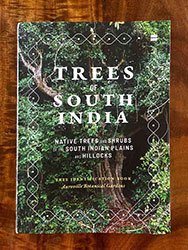
Trees of South India (Published by Harper Collins, 2024)
A detailed and easy-to-use pictorial guide to identify 190 ecologically important species of native trees and shrubs, resulting from over 50 years’ of dedicated work restoring and researching the forests and native trees of the Coromandel Coast and the plains and hillocks of South India. It includes many rare and threatened plants such as satin wood, poplar-leaved ardor, Indian kino, red sanders and rosewood, etc. and is a resource for amateur naturalists, plant explorers and conservationists interested in learning about indigenous flora and working towards their preservation.

40 Evergreen Trees of Auroville: Tree Identification Booklet
A short collection in booklet form introducing 40 species out of the larger work of the Trees of South India book.

Our History (2019)
The story of how the Botanical Gardens came to be, a journey through the plants and the people over the last 20 years.
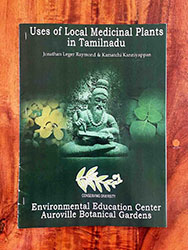
Uses of Local Medicinal Plants in Tamil Nadu (2011)
24 common plants from our medicinal garden that are easy to use and easy to grow in our local area.

Dye Colour
An introduction to the Dyeing plants of Tamil Nadu and how to use them. It was the culmination of one of our volunteer’s 12 months program at the gardens, and is an accompaniment to the new Colour Garden that has been created to host the plants.

Once Upon a Pond (2017/18)
A colouring book that we designed, drew and wrote here at the gardens. It is the story of a special frog, called Freddie, who is different from the other frogs, and what happens the day a large Heron arrives.
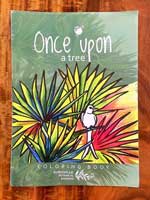
Once Upon a Tree (2017/18)
Once upon a lazy day, a cow and her friend Diddi the drongo, were laying in the shade of the palmyra when all of a sudden they heard a noise…
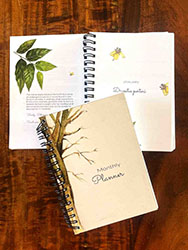
The Auroville Botanical Gardens Planner/Notebook
An undated planner/notebook with the theme of getting to know 12 threatened species of the TDEF (Tropical Dry Evergreen Forest), accompanied by delightful hand-painted illustrations.
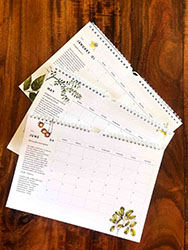
The Auroville Botanical Gardens calendar (2024)
A charmingly hand-illustrated calendar for the year introducing us to selected rare species found in and around the plains of Tamil Nadu.
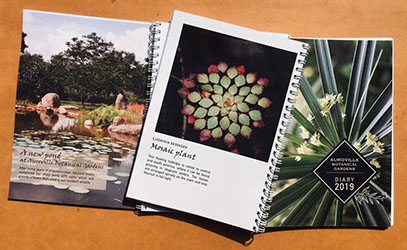
The Auroville Botanical Gardens Diary (2019)
This year in our diary we are celebrating ponds and water bodies, as they are important resources for wildlife and aid us in our quest to support the conservation of biodiversity.
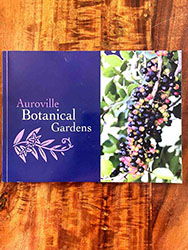
Auroville Botanical Gardens Booklet
An overview of and introduction to the Gardens in booklet form, sharing the spirit of the Gardens, some of our core work, and many of its wonders.
Singing birds
Yellow-billed Babbler or Seven sisters
Turdoides affinis – Thavittu Kuruvi தவிட்டுக் குருவி
Rather dull-looking, Babblers have a grey brown body, a grey throat and a yellowish-buf belly. Eyes are bluish white. In the plains of South India, you may also find the Jungle and the Common Babbler but the most present is the Yellow-billed Babbler who has, compared to the others, a whitish crown and nape, with a darker mantle.
Read More
SIZE
23 cml
FOOD
Insects, but also fruits, nectar and human food scrap.
HABITAT
Gardens, urban and suburban areas.
BEHAVIOR
Also commonly known as Seven Sisters because of its habit of moving around in a small flock typically numbering around 6-8 birds. It does not fly long distances. It usually gains height by moving up a tree or tall shrub.
SONG & CALL
Very high-pitched. Its normal call is a musical trr-ri-ri ri uttered by one or more of the flock while the others hop around feeding. When an intruder arrives, this call is taken up by the whole flock, increasing to an excited, loud and discordant chorus of squeaking and chittering.
FUN FACTS
Each Babbler has its place and specific role within the community. Some individuals act as sentinels, keeping a lookout for predators, while others forage for food. There are also individuals assigned to care for and feed the young chicks. This cooperation and division of responsibilities contribute to the group’s overall survival.
Coppersmith Barbet
Megalaima haemacephala – Semmarbu Kukuruvan செம்மார்பு குக்குறுவான்
A small brightly-coloured bird with a crimson breast and forehead. it has a grass-green plumage, yellow throat, dark streaking on its belly and flanks, and bright red legs and feet.
Read More
SIZE
17cm
FOOD
Mainly fruits, berries and sometimes insects.
HABITAT
Groves, light forest, city gardens, roadside trees.
LIFESTYLE
It is solitary or lives in small groups. It can climb up trunks like a woodpecker. It often spends early mornings sunning on bare branches.
SONG & CALL
The call is a loud, rather metallic Tuk…Tuk…Tuk (or tunk), reminiscent of a copper sheet being beaten, giving the bird its name. Repeated monotonously for long periods, starting with a subdued Tuk and building up to an even volume and tempo.
FUN FACT
It can eat nearly 1.5 to 3 times its own body weight in berries each day.
Red-vented Bulbul
Pycnonotus cafer – Chinnan – சின்னான்
Its plumage is predominantly brownish-grey, with a striking black crest adorning its head, and a white belly. The most distinctive feature is the vivid red patch beneath its tail, which contrasts sharply with its otherwise muted coloration.
Read More
SIZE
20cm
FOOD
Omnivorous. Fruits, flower buds, insects, and nectar.
HABITAT
Gardens, wooded areas, forests, and even urban parks.
LIFESTYLE
It is a social bird, often seen in pairs or small groups, chirping and flitting through trees and bushes. These agile fliers are swiftly navigate through dense vegetation in search of food, while communicating with other members of its group.
SONG & CALL
Its song is a medley of whistles, trills, and cheerful warbles. Besides its song, its calls include distinct Oo-ee or Ka-oh sounds, which it uses for communication within its group or to mark its territory.
FUN FACT
In 19th-century India, this bird was frequently kept as a cage pet and for fighting, especially in the Carnatic region. It was held on the finger with a thread attached to its leg and when it fought it pulled out the red feathers of its opponents.
White-browed Bulbul
Pycnonotus luteolus –Venpuruva Chinnan – வெண்புருவ சின்னான்
Its body is mostly olive-brown, and it has a creamy-white underbelly. It has a distinctive white stripe above its eyes, contrasting with its black head. It has a slender, curved bill and a long tail.
Read More
SIZE
20cm
FOOD
Insects, fruits like banyan and peepal figs, berries and nectar.
HABITAT
Dry open scrub country, plains, gardens and woodlands with dense shrubbery.
LIFESTYLE
Usually seen singly or in pairs, it hides in dense, low growth from where its chattering calls suddenly explode, seen only momentarily when it emerges on bush tops, or flies low from one bush patch to another. It usually does not associate with other birds.
SONG & CALL
It is rather noisy but uncommonly seen. Its call is a cacophonous explosion of loud discordant babbles, usually lasting 1-3 seconds. Its calls can be a rasping Churr.
FUN FACT
It plays a significant role in dispersing seeds by consuming fruits and then spreading the seeds elsewhere.
Southern Coucal
Centropus sinensis parroti – Senbagam – செண்பகம்
Its glossy black head and body plumage, contrast with its chestnut mantle and wings. It has red eyes, a strong bill and a long graduate tail.
Read More
SIZE
50cm
FOOD
Insects, lizards, frogs, eggs, young birds, and small snakes.
HABITAT
Open woodlands, grasslands, cultivated areas, scrub, edges of forest.
LIFESTYLE
Solitary or in pairs it moves amidst dense vegetation. It settles in the trees, but is a poor flyer, lazily flying short distances. Largely terrestrial. One of the non-parasitic Cuckoos.
SONG & CALL
It has a unique, deep booming call that resonates through the forest. Its most common call is a series of loud, low-pitched Coop-coop-coops or Woo-woo-woo notes in varying tempo/speed in runs of 6-7 at a time, though up to 20 has been heard. Often in duets with another nearby bird (if it is the mate, the female is recognisable by her lower pitched call). During courtship, it may also utter a mixture of harsh, weird croaks and chuckles.
FUN FACT
It is quite meticulous about its appearance. It uses its long tail to balance. It often engages in preening to keep its feathers tidy.
Indian Jungle Crow & House Crow
Corvus culminatus & Corvus splendens – Andan kakai – அண்டங் காக்கை & காக்கை
The House Crow is entirely glossy black, with a heavy black bill with a pronounced curved culmen. The Indian Jungle Crow has a smoky-grey collar, nape, neck and breast.
Read More
SIZE
40cm
FOOD
Opportunist and generalist omnivore.
HABITAT
Inhabited and cultivated areas. Wide range of habitats with trees.
LIFESTYLE
Usually seen singly, in pairs or in small groups. Highly adaptable and intelligent. It is capable of solving complex problems and using tools to obtain food. A quick learner, it can recognizes individual humans, especially those who regularly provide food.
SONG & CALL
Its calls include harsh Kaaa-kaaa and guttural sounds, often varied in pitch and tone. It uses distinct calls to communicate within its groups, to indicate danger, signal food sources, or establish territory. During interactions, it may create a series of sharp, repeated Caws.
FUN FACT
It may soften its food by dropping it in water and has also been observed to eat sand after feeding on meat from a carcass.
Common Hawk-Cuckoo or Brainfever
Hierococcyx varius – Akka Kuyil – அக்காகுயில்
Its plumage is ashy grey on top and a whitish below, cross-barred with brown. The tail is broadly barred. It has a distinctive yellow eye ring. At first glance it can be mistaken for a Shikra Hawk.
Read More
SIZE
34cm
FOOD
Mostly insects, rarely wild fruit and small lizards.
HABITAT
Forests, open country, near habitation.
LIFESTYLE
Solitary, rarely in pairs, strictly arboreal.
SONG & CALL
Famous call, uttered untiringly in crescendo, also described as Pi-pee-ha…. Pi-pee-ha…. Call may be heard all through the day, starting early before dawn. Mostly silent during rains. Becomes increasingly louder with the summer and during moonlit nights.
FUN FACT
The call of this bird has been popularly transcribed as Brain-fever in English. But other interpretations of the bird call include piyaan kahar in Hindi (“where’s my love”) or chokh gelo (in Bengali, “my eyes are gone”) and paos ala in Marathi (“the rains are coming”).
Spotted Dove
Pilopelia chinensis – Pulli pura – புள்ளிப்புறா
Long tailed buff brown with a white-spotted black collar patch on the back and sides of the neck. The tail tips are white and the wing coverts have light buff spots.
Read More
SIZE
32cm
FOOD
Grass seeds, grains, fallen fruits and seeds. Occasionally winged termites.
HABITAT
Light forests, gardens and urban areas.
LIFESTYLE
Mostly found on the ground in pairs or small groups where it forages for seeds and grain. It takes flight from the ground with an explosive flutter.
SONG & CALL
Its vocalizations include cooing softly with a Krookruk-krukroo…kroo kroo kroo. The number of terminal kroos vary from 3 to 6.
FUN FACT
In various cultures, Doves are symbols of peace, love, and harmony. The gentle nature and soothing cooing of the Spotted Dove have inspired poets, artists, and storytellers across time.
Black Drongo
Dicrurus macrocercus – Karungkarichan – கருங்கரிச்சான்
Glossy black bird with a wide fork to the tail. Juveniles are brown and may have some white barring or speckling towards the belly and vent.
Read More
SIZE
23cm
FOOD
It is mostly an aerial predator of insects but can also hunt forage from the ground. Preys rarely on small birds, reptiles, or bats.
HABITAT
Open agricultural areas and light forest.
LIFESTYLE
Often seen on a bare perch, telephone line, or on grazing animals. Known for its fearless behaviour towards much larger birds, such as crows, never hesitating to dive-bomb any bird of prey that invades its territory. It is capable of fast manoeuvres that enable it to capture flying insects.
SONG & CALL
Although it is capable of producing a fairly wide range of calls, its most common call is a two-note Tee-hee or Ti-tiu resembling that of the Shikra Hawk. It also utters a harsher-sounding chattery Cheece-cheece-chichuk. At the start of the breeding season, it can be heard indulging in noisy duets, mainly during the hour or two before daybreak.
FUN FACT
Known to feed late in the night on insects attracted to artificial lights.
Tickell's or Pale-billed Flowerpecker
Dicaeum erythrorhynchos – Tickel malarkothi – டிக்கெல் மலர்கொத்தி
This bird is one of the smallest in South India. Its plain brown to olive green colouring makes it dull-looking. It has a pale and bulky curved bill.
Read More
SIZE
8cm
FOOD
It sips nectar from flowers, pollinating them in the process. It also feeds on the pulp of small berries.
HABITAT
Forest and urban areas with fruiting trees.
LIFESTYLE
It is a very restless bird, flying from tree to tree and hopping from flower to flower.
SONG & CALL
Its songs include the most high-pitched trill of birds around. The bird flies from tree to tree while uttering its incessant and rapid Chik-chik-chick call.
FUN FACT
This bird is associated with the spread of a parasitic plant. When the seed is excreted, it sticks to the bird. Then to get rid of it, the bird rubs against the branches, thus causing the seed to stick in place and grow there.
Grey Francolin
Copsychus fulicatuss pondicerianus – Kowdhari – கௌதாரி
It is grey-brown, barred throughout, with a pale face. In flight, it shows a chestnut short tail. Males are larger than females.
Read More
SIZE
30cm
FOOD
Seeds and insects, particularly termites and beetles.
HABITAT
Open fields, thorn scrub and light dry jungle.
LIFESTYLE
It’s a fast runner but weak flyer. It flies short distances, escaping into undergrowth. It normally forages on bare ground in scrub and open country. It is usually seen in small groups.
SONG & CALL
The loud calls of the birds are commonly heard early in the mornings. Pairs of birds will sometimes engage in a duet. The female call is a Tee-tee-tee repeated and sometimes a Kila-kila-kila and the challenge call Kateela-kateela is a duet.
FUN FACT
The male engages in unique dances and strutting displays to impress the female. It might bob its head, strut around in circles, or perform rhythmic movements accompanied by its calls. It can also engage in playful chasing or pursuit behaviour.
Eurasian Hoopoe
Upupa epops – Kondalathi – கொண்டலாத்தி
It is a distinctive orange-cinnamon bird with zebra-striped black and white wings, a tall erectile crest, and a long, narrow downcurved bill.
Read More
SIZE
32cm
FOOD
Mostly insects, although small reptiles, frogs, seeds and berries are eaten as well.
HABITAT
Open ground rich in insects to forage and cavities to nest.
LIFESTYLE
It makes seasonal movements in response to rain in the Western Ghats. It has a characteristic undulating flight, like a giant butterfly. It is a solitary forager that typically feeds on the ground.
SONG & CALL
Its call is a soft Oop-oop-oop. The call is typically trisyllabic, although 2 and 4 syllables are also common. Other calls include rasping croaks, when alarmed, and hisses. The female produces a wheezy note during courtship feeding by the male.
FUN FACT
It has well-developed anti-predator defence in the nest. A gland of the incubating and brooding female is modified to produce a foul-smelling liquid, and the glands of nestlings do so as well. These secretions smell like rotting meat, helping deter predators, as well as deterring parasites through its antibacterial properties.
Common Iora
Aegithina tiphia – Manjal Chittu – மஞ்சள் சிட்டு
It’s a brightly-coloured small passerine bird with a pointed and notched beak and lots of plumage variation. The male has black wings with two white bars and a black tail. The female has greenish wings and an olive tail. The underparts are yellow in both males and females.
Read More
SIZE
13cm
FOOD
Mainly insects and spiders.
HABITAT
Wooded areas, scrub and cultivated lands. But also gardens and urban parks.
LIFESTYLE
It forages in trees in small groups, searching among the branches for insects. It sometimes joins mixed species feeding flocks. Once it lands, it spreads its tail and droops its wings.
SONG & CALL
This bird is quite vocal and can produce a wide variety of calls. It is easily detected from its common loud whistles Wheeeee-tee with 2 notes: the first one is longer and higher pitched than the second one. This song often consists of phrases that are repeated in sequences, creating a distinctive and pleasant sound. Apart from this, it utters variable Chirrs and chattering.
FUN FACT
During breeding season, the male has brighter plumage and a black cap. It moults twice in a year and the plumage variation makes it somewhat complicated for identification.
White-throated Kingfisher
Halcyon smyrnensis – Venmarbu meenkothi – வெண்மார்பு மீன்கொத்தி
This large Kingfisher has a bright blue back, wings and tail, a chocolate-brown head and lower belly, and a white throat and breast. Its large bill and legs are bright red. In flight, large white patches are visible on its blue and black wings.
Read More
SIZE
27cm
FOOD
Fishes, frogs, lizards, insects and occasionally scorpions, small mice and even young birds.
HABITAT
Open country, forest, cultivated areas, lakes, riversides, coastal mangroves and estuaries.
LIFESTYLE
Solitary, or in scattered pairs perched on wires, poles and trees. Dives to the ground or over water to catch prey.
SONG & CALL A noisy, loud crackling laugh, often audible over crowded urban areas. A longish quivering whistle, sounding as Kililililili… with song tonality decrescendo, a characteristic feature when birds are breeding. Kit-kit-kit uttered in flight. The female in invitation makes a rapid and prolonged Kat kat katcall.
FUN FACT
Oddly enough, it can’t swim. When fishing, it plunges in from nearby perches, where it may sit patiently for long periods. It can plummet, strike, and be back on its perch in 2-3 seconds, reaching speeds of over 40 km per hour as it enters the water. Even if it likes fish, it can also be found far from water.
Asian Koel
Eudynamys scolopacea – Kuyil – யில்
Males have a metallic black plumage and greenish beak. Females are dark brown on top, spotted and barred with white and buff, and are white below, strongly barred with dark brown. Both have brilliant red eyes.
Read More
SIZE
43cm
FOOD
Omnivorous, consuming a variety of insects, caterpillars, eggs and small vertebrates.
HABITAT
Light forests, orchards, city parks, fields and open areas.
LIFESTYLE
Solitary or in pairs, it is arboreal and spend most of its time in leafy trees and shrubs. Its presence often goes unnoticed.
SONG & CALL
A loud, rising and increasingly anxious repeated Kuoo-kuoooo and a bubbling more rapid repeated Koel-koel. The female only utters a sharp, quick, repeated Kik kik kik kik as she dashes from tree to tree.
FUN FACT
It is a brood parasite, laying its single egg in the nest of many other birds, including crows. The young Koel does not always push out eggs or the host chicks. Its initial call is like that of a Crow.
Yellow-wattled Lapwing
Vanellus malabaricus – Manjalmooku aalkati – மஞ்சள்மூக்கு ஆள்காட்டி
It has a black head. Its back and wings are greyish brown, and the belly is white. The most remarkable feature is its yellow legs and fleshy wattles, which hang below its eyes.
Read More
SIZE
26cm
FOOD
Mainly insects, particularly beetles, ants, grasshoppers, and other small invertebrates.
HABITAT
Open grasslands, fields, marshes, and the edges of water bodies.
LIFESTYLE
Although it does not migrate, it is known to make seasonal movements in response to rain. It forages by walking slowly on the ground, using its long bill to probe for food in the soil and vegetation.
SONG & CALL
Its call is a sharp Pee-wit or Keek-keek-keek, often repeated loudly. This call is heard during their breeding season to signal potential danger or to maintain contact within the group.
FUN FACT
When disturbed or feeling threatened, it may pretend to have a broken wing to distract predators from its nest or young chicks.
Common Myna
Acridotheres tristis – Myna – மைனா
It is a medium-sized bird with a brown body, a black head, yellow around the eyes, and a bright yellow beak and legs. It has white wing patches that are visible when it flies.
Read More
SIZE
24cm
FOOD
Omnivorous. Insects, fruits, seeds, scraps of food, and occasionally small reptiles or small mammals.
HABITAT
Adaptable, including urban areas, parks, gardens, open woodlands, and farmlands.
LIFESTYLE
Very common and familiar bird. Hardly ever stays far from man and habitation, rather confident in looks, aggressive, curious and noisy, often seen on the ground. It pecks for worms, and attends to grazing cattle. It can enter in verandas, kitchens, and sometimes steals from the dining table.
SONG & CALL
It has a wide variety of calls, ranging from cracks, squawks, chirps and clicks to whistles, some expressive of passing moods, others of emotions such as pleasure, contentment, alarm, anger or agitation. One of its more familiar calls is a loud scolding Raadio-raadio-raadioa. An excellent mimic, it can imitate a wide variety of sounds, including human speech, other bird calls, and even car alarms or mobile phone ringtones.
FUN FACT
Some people keep Common Mynas as pets due to its mimicry abilities and sociable nature. However, it is considered invasive, and efforts are being made to reduce its negative impacts on native wildlife.
Indian Golden Oriole
Oriolus kundoo – Manguyil – மாங்குயில்
It is a stunning bird with bright golden-yellow plumage. The male has a black head, wings, and tail, with yellow feathers covering most of its body. The female has a more subdued yellow colour with some grey on its head and wings.
Read More
SIZE
25cm
FOOD
Fruits, insects, and nectar. It likes ripe fruits like mangoes and figs.
HABITAT
Forest, orchards, gardens, often in inhabited areas.
LIFESTYLE Shy, it rarely descends to the ground. Known for its acrobatic flight, often gliding gracefully between trees while searching for food.
SONG & CALL
Its melodious song consists of a series of varied whistles, warbles, and musical notes. It’s a flute-like sound, like Weela-wee-ooo, Wiel-a-wo or Pee-lo-lo… Its basic call, usually near the nest in the period before dawn, is a harsh Chee-ar.
FUN FACT
While its bright yellow plumage might seem conspicuous, it provides excellent camouflage, making it challenging to spot.
Mottled Wood Owl
Strix ocellata – Poripulli Aandhai – பொரிப்புள்ளி ஆந்தை
It is a stunning bird with intricate patterns of brown, grey, and white feathers. It has large and dark captivating eyes, prominent against its pale face. The wingspan is large, about 90 to 107cm.
Read More
SIZE
42cm
FOOD
Nocturnal hunters of small mammals like rodents, insects, reptiles, and occasionally, smalle birds.
HABITAT
Dense forests and wooded areas with ample trees for roosting during the day and hunting at night.
LIFESTYLE Solitary creatures, usually seen alone or with their mate. It is most active during the night.
SONG & CALL
Thanks to its facial disc, it has excellent hearing. Just by listening, it can precisely locate its prey in the dead of night. It has a diverse range of calls and often produces a distinct series of deep hoots, described as a low, rhythmic Ho-ho-hoo hoo hoo.
FUN FACT
The courtship includes a unique dance, where it might bob its head, swollen its feathers, and even offer gifts of food to impress its potential partners.
Spotted Owlet
Athene brama – Pulli Aandhai – புள்ளி ஆந்தை
Relatively small, it has a round head with prominent white eyebrows. Its plumage features a brown and white spotted pattern. Its eyes are large and yellow, providing excellent night vision.
Read More
SIZE
20cm
FOOD
Insects such as beetles, grasshoppers, crickets, and small rodents. Occasionally small birds or reptiles.
HABITAT
Open woodland areas, farmlands, parks, and urban environments. It is adaptable and can thrive in diverse landscapes.
LIFESTYLE
It is nocturnal but often seen during the day. When disturbed from its daytime site, it bobs its head and stares at intruders.
SONG & CALL
A harsh screeching Chirurrr-Chirurrr-Chirurrr followed by, or alternating with Cheevak-Cheevak-Ccheevak and a variety of other screeches and chuckles.
FUN FACT
This bird, very familiar to humans especially with its loud calling, has been associated with bad omen. The species name brama refers to Brahma, the Hindu god of creation.
Rose-ringed Parakeet
Psittacula krameri – Pachaikkil – பச்சைக்கிளி
It shows a predominantly green body, with a distinctive rose-coloured ring around its neck, and long tail feathers. The female lacks this ring and has a more subtle coloration. Its beak is strong and hooked.
Read More
SIZE
36cm including tail
FOOD
Omnivorous, seeds, fruits, nuts, berries, flowers, and occasionally, insects and larvae.
HABITAT
One of the few parrot species that have successfully adapted to urbanisation and disturbed habitats.
LIFESTYLE
Often seen in flocks, chattering and foraging together. It is an agile flyer, displaying acrobatic manoeuvres in flight, and has a curious nature.
SONG & CALL
It is a noisy species, with an unmistakable loud, sharp, screaming Keeak-keeak-keeak call uttered both at rest and flying, though it can remain very quiet when it suits them. It emits a variety of calls, from sharp squawks to melodious chattering. It is quite vocal during its flight, communicating with other members of their flock.
FUN FACT
Both males and females have the ability to mimic human speech. First, the bird listens to its surroundings, and then it copies the voice of the human speaker. Some people hand-raise rose-ringed parakeet chicks for this purpose. Such parakeets then become quite tame and receptive to learning.
Indian Peafowl or Peacock
Pavo cristatus – Neela Mayil – நீல மயில்
A striking bird with vibrant colours. The male is known for its iridescent blue-green plumage, a magnificent fan-shaped tail with colourful “eyespots,” and a crest on its head. The female, called Peahen, has a more subtle brown or grey plumage.
Read More
SIZE
90cm to 1m30 with the train
FOOD
Omnivorous. Seeds, insects, fruits, small mammals and reptiles.
HABITAT
Forests, open grasslands, and cultivated areas.
LIFESTYLE
A social bird often found in small groups called parties. It forages on the ground and usually tries to escape through undergrowth and avoid flying. It flies into tall trees to roost. It is fond of dust-bathing and at dusk, groups walk in single file to a favourite waterhole to drink.
SONG & CALL
The male Peacock produces a loud, distinctive call known as a “scream” or “meow” that sounds like May-awe or Kee-ow. During mating season, the male also creates rattling sounds by vibrating its tail feathers to attract female. Other different alarm calls are commonly produced by both sexes.
FUN FACT
Known as Mayura in Sanskrit, is frequently depicted in temple art, mythology, poetry, folk music and traditions. Native to India, it became the national bird.
Oriental Magpie Robin
Copsychus saularis – Vannathi Kuruvi – வண்ணாத்திக் குருவி
It is a charming bird with distinctive black and white plumage. The male showcases a glossy black upper body contrasted with a brilliant white belly, while the female is more muted in shades of grey. It has a long tail that it often moves up and down while perched.
Read More
SIZE
20cm
FOOD
Insects like beetles, caterpillars, grasshoppers, and spiders. Occasionally, fruits and seeds.
HABITAT
Diverse habitats, from forests and woodlands to gardens and urban parks. It is adaptable and can be seen perched on fences and branches.
LIFESTYLE
Known for its friendly nature, it is curious and agile. It hops around in search of food, often with quick, jerky movements. It may even follow humans in gardens.
SONG & CALL
One of the finest singers. Its songs consist of a blend of chirps, warbles, and melodious whistles. Its main song is a soft series of musical, sad-sounding Swee-ee or Swee-swee that can be heard during the early mornings and late evenings. It also comes out with occasional bursts of loud, sharp Chee-witch-witch calls, quite different from the tuneful song used in the breeding season.
FUN FACT
It has good mimicry skills, sometimes imitating other bird calls or sounds it hears in its surroundings. Studies made of its song show it has dialects, its song varying by region.
Indian Robin
Saxicoloides fulicatus – Karunjittu – கருஞ்சிட்டு
The male has a brown to all-black back, with a white shoulder patch. Its long tail (6 to 8 cm) is usually held up and shows the chestnut under its tail coverts, which is a distinctive sign. The female is brown on top and grey below and has no white shoulder stripe.
Read More
SIZE
15cm
FOOD
Mostly insects but also frogs and lizards when feeding its young during nesting.
HABITAT
Open stony, grassy and scrub forest. Often close to human habitation.
LIFESTYLE
It runs in short spurs along the ground, hunting or perches on low thorny shrubs and rooftops. Solitary or in pairs. Rather suspicious, it maintains a safe distance from humans. Individuals may forage late in the evening to capture insects attracted to lights.
SONG & CALL
Its songs are characterized by a combination of rich whistles, warbles, and chirps. The male has variants for inviting mates and for deterring other males. The call is a long-drawn Sweeeech or Weeeech. The warbling song, which is also the breeding song, is a guttural charr note.
FUN FACT
During the breeding season, the male can be aggressive to others. It has been seen attacking its own reflection on car or bike mirrors.
Loten's, Purple and Purple-rumped Sunbird
Cinnyris lotenius, Cinnyris asiaticus & Leptocoma zeylonicaThenchittu – தேன்சிட்டு
In the plains of South India, you might find these 3 different sunbird species. They are small with downward-curved bills. Loten’s and Purple males are quite similar, they are mainly glossy purple but the Loten’s has a grey-brown belly and a red patch on the throat. The female has an olive-green upperpart and a yellowish underpart. The Purple-rumped male has a green metallic crown, a dark brown body with a purple rump and throat, lemon-yellow underpart, and whitish flanks. The female is light greyish-brown above and pale yellow below.
Read More
SIZE
10cm
FOOD
Nectar, but will also eat insects and spiders, especially when feeding their young.
HABITAT
Forest, gardens
LIFESTYLE
It is active and agile, moving swiftly among flowers to feed on nectar. It possess remarkable flight agility, allowing it to hover while feeding.
SONG & CALL
Its calls are a mix of chirps and short musical notes. Fairly loud and sharp Tchit Tchit call and Chewit Chewit notes.
FUN FACT
When it can’t have access to a flower’s nectar because of its shape (for example, very long and narrow flowers), it simply punctures the flower at the base near its nectary, from which it sips the nectar.
Common Tailorbird
Orthotomus sutorius – Thaiyal Chittu – தையல் சிட்டு
It features a greenish upper body with a white underside. Its distinct features are the rufous crown stripe and the long tail that it cocks upwards frequently.
Read More
SIZE
12cm
FOOD
Insects, spiders, caterpillars, beetles, and other small invertebrates. Occasionally, fruits and nectar.
HABITAT
Common resident in urban gardens, woodlands, thickets and shrublands.
LIFESTYLE
Energetic and agile, it is known for its active movements within the foliage. It darts and flies through the bushes, often disappearing from sight due to its small size and quick movements. Singly or in pairs, usually low in the undergrowth or trees, sometimes hopping on the ground.
SONG & CALL
Its song is a series of loud, melodious and repetitive notes, that it sings tirelessly and is often described as Tuui-tuui-tuui-tuui-tuui-tuui…
FUN FACT
It get its name from the way its nest is constructed. The edges of a large leaf are pierced and sewn together with plant fibre or spider silk to make a cradle in which the actual nest is built.
Rufous Treepie
Dendrocitta vagabunda – Val Kakkai – வால் காக்கை
It is a member of the Crow family, with a combination of black, white, and cinnamon-brown plumage. It has a black head, cinnamon-brown belly and back, a distinctive white bar on its wings and a long, graduated bluish grey tail finishing with a black tip. Its black bill is stout with a hooked tip.
Read More
SIZE
47cm
FOOD
Omnivorous. Fruit, nectar, seeds, invertebrates, small reptiles, eggs and young birds.
HABITAT
Open forest, wooded areas, gardens, and urban areas.
LIFESTYLE
Known for its high intelligence, it is an agile forager, clinging and clambering through the branches and sometimes joining mixed hunting parties along with species such as Drongos and Babblers.
SONG & CALL
Wide repertoire of calls, but its common call is a fluty guttural three-note Bob-o-link or harsh Ko-tree.
FUN FACT
It has a reputation for being quite bold and is known to snatch food from picnic tables or even from people’s hands if given the chance.
White-breasted Waterhen or Swamp Chicken
Amaurornis phoenicurus – Venmarbu Kanankozhi – வெண்மார்பு கானாங்கோழி
It has dark grey upper parts and flanks, and a white face, neck and breast. Its lower belly and undertail are cinnamon or white-coloured. Its body is flattened laterally to allow it easier passage through the reeds or undergrowth. It has long toes, a short tail, a yellow bill and yellow legs.
Read More
SIZE
33cm
FOOD
Insects, small fishes, frogs, seeds, and various aquatic plants.
HABITAT
Near marshes, ponds, lakes and wet grasslands.
LIFESTYLE
It is somewhat bolder than most other Waterhen and is often seen stepping slowly with its tail cocked upright in open marshes. It probes with its bill in mud or shallow water, also picking up food by sight.
SONG & CALL
Its call is a loud and repetitive distinctive Kuk-kuk-kuk or Kek-kek-kek sound. A series of hooting, grunting, or rasping notes or phrases, repeated monotonously, mainly during crepuscular time, just after the first rains and during breeding season.
FUN FACT
It is an excellent runner and swimmer but may fly for short distances when necessary.
Black-rumped Flameback Woodpecker
Dinopium benghalense – Ponmudhugu Marangothi – பொன்முதுகு மரங்கொத்தி
The male has a black throat, black rump, and a vivid red crown that extends down its nape. Its back is black with white spots, and its wings are barred with black and white. The female looks similar but lacks the red crown, having a black forehead instead. Like other Woodpeckers, it has a straight pointed bill and zygodactyl feet, with two toes pointing forward and two backward.
Read More
SIZE
28cm
FOOD
Insects, mainly beetle larvae from under the bark and termites.
HABITAT
Forests, orchards, gardens, in neighbouring villages and other habitation.
LIFESTYLE
It is normally seen in pairs or small parties and sometimes joins mixed species foraging flocks. It climbs up and down tree trunks, using its stiff tail feathers for support.
SONG & CALL
Its call is a single strident Klerk and a whinnying laughing Kyi-kyi-kyi that echoes through the forest. It also makes distinct drumming sounds by pecking on trees.
FUN FACT
To reach insects deep within the tree bark, it has an exceptionally long and sticky tongue. This helps it to extract insects from crevices that would be challenging for other birds.
